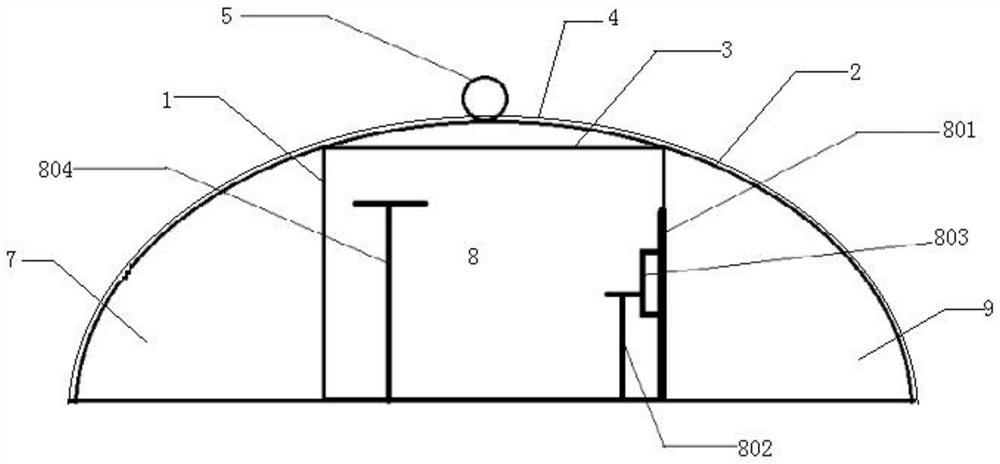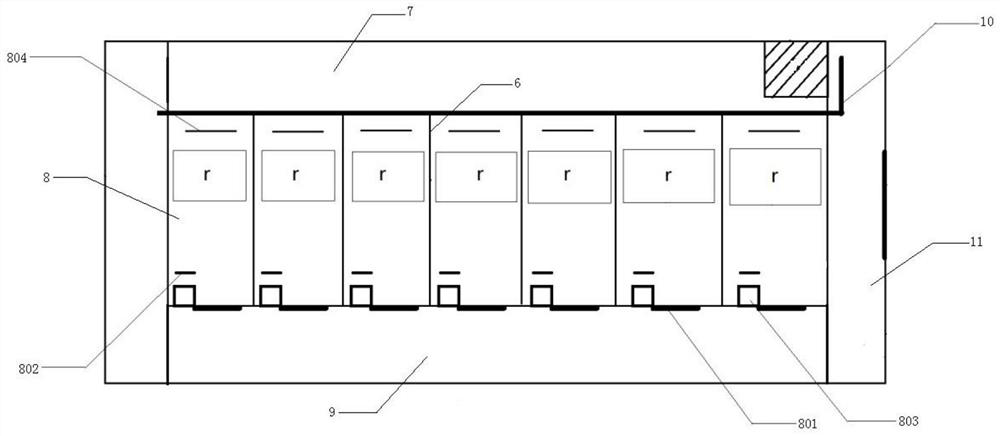Wasp and locust combined out-of-season breeding greenhouse and breeding method thereof
A breeding method, locust technology, applied in the field of wasp breeding, can solve the problems of farmers having no economic income, and achieve the effect of rapid growth and filling the vacancy of bee pupae
- Summary
- Abstract
- Description
- Claims
- Application Information
AI Technical Summary
Problems solved by technology
Method used
Image
Examples
Embodiment 1
[0033] figure 1 , 2 Shown is: a combined anti-season breeding greenhouse for wasps and locusts, comprising a column 1, an arch 2, a beam 3, a plastic film 4 and a roller shutter 5, the column 1, the arch 2 and the beam 3 constitute a greenhouse scaffolding, and the shed The frame is covered with a plastic film 4, and the outer wall of the plastic film 4 is covered with a roller blind 5, and the roller blind 5 can not only shade, ventilate but also keep warm.
[0034] The entire greenhouse is divided into locust breeding area 7, wasp breeding area 8 and forage grass planting area 9 by isolation net 6 along its width direction, wherein, wasp breeding area 8 is divided into multiple beekeeping areas by isolation net 6 along the length direction of the greenhouse. In a single room, a heating device 10 is arranged between the locust breeding area 7 and the wasp breeding area 8. The heating device 10 can adopt circulating hot water heating or electric heating to control the tempera...
Embodiment 2
[0040] A combined off-season breeding method for wasps and locusts, characterized in that it comprises the following steps:
[0041](1) Before the queen bee survives the winter, artificial feeding is carried out to supplement nutrition, feeding honey water and apple juice, and feeding for 7-10 days to enhance the queen bee's physique. Place the queen bee 15-18 days after overwintering in the control room, and gradually raise the temperature to 16-18°C
[0042] (2) After 2 to 3 days, the queen bee wakes up and is artificially fed with a nutrient solution prepared with honey, vitamins, minerals and water. When the queen bee moves normally, separate the cages, put the queen bee into the nesting chamber alone, and raise the temperature to 23-25°C. The nesting room is composed of a nesting area and an activity area. The nesting area is a hollow box with a transparent observation window at the bottom, and a through hole is opened on the side wall, and a conical plastic net is conne...
Embodiment 3
[0050] A combined off-season breeding method for wasps and locusts, characterized in that it comprises the following steps:
[0051] (1) Before the queen bee survives the winter, artificial feeding is carried out to supplement nutrition, and honey water and apple juice are fed for 8 days to enhance the queen bee's physique. Place the queen bee 17-20 days after overwintering in the control room, and gradually raise the temperature to 18-20°C
[0052] (2) After 2 to 3 days, the queen bee wakes up and is artificially fed with a nutrient solution prepared with honey, vitamins, minerals and water. When the queen bee moves normally, separate the cages, put the queen bee into the nesting chamber alone, and raise the temperature to 23-25°C. The nesting room is composed of a nesting area and an activity area. The nesting area is a hollow box with a transparent observation window at the bottom, and a through hole is opened on the side wall, and a conical plastic net is connected to the...
PUM
 Login to View More
Login to View More Abstract
Description
Claims
Application Information
 Login to View More
Login to View More - R&D
- Intellectual Property
- Life Sciences
- Materials
- Tech Scout
- Unparalleled Data Quality
- Higher Quality Content
- 60% Fewer Hallucinations
Browse by: Latest US Patents, China's latest patents, Technical Efficacy Thesaurus, Application Domain, Technology Topic, Popular Technical Reports.
© 2025 PatSnap. All rights reserved.Legal|Privacy policy|Modern Slavery Act Transparency Statement|Sitemap|About US| Contact US: help@patsnap.com


